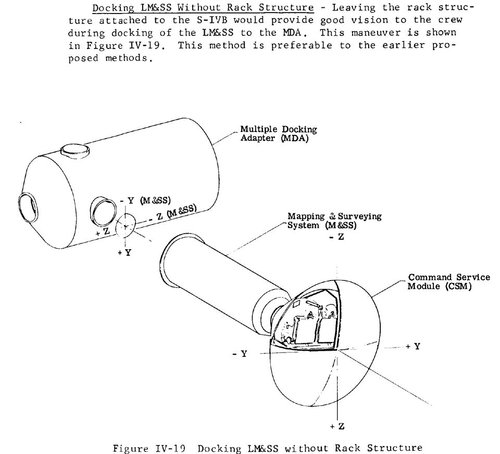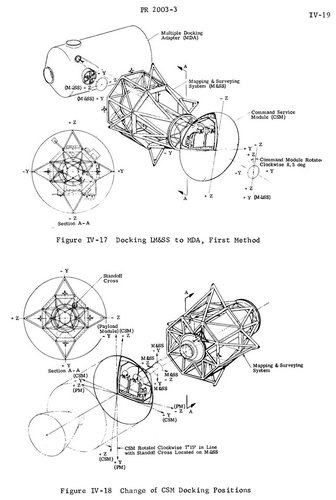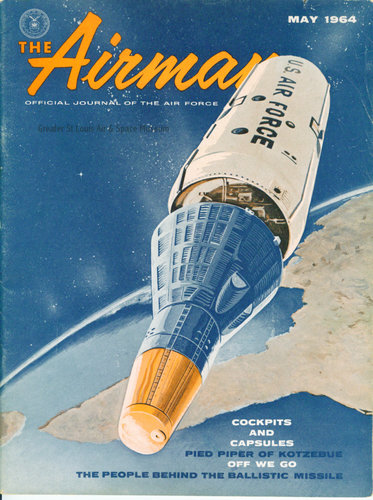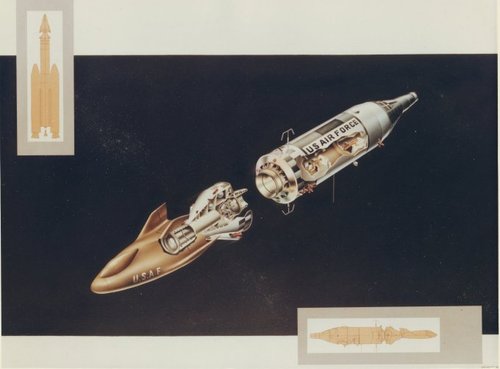You are using an out of date browser. It may not display this or other websites correctly.
You should upgrade or use an alternative browser.
You should upgrade or use an alternative browser.
MOL
- Thread starter Barrington Bond
- Start date
I red again that document, which is too large for the (dumb) attachment system.
58. Project UPWARD- The NRO and NASA History-2
Gambit 1 = Agena + G.E OCV + camera
Gambit 3 = Agena + improved camera (> gone is G.E OCV)
UPWARD = Apollo + Gambit 1 camera + Lockheed Gambit 3 "payload module"
PERCHERON = GAMBIT 1 = Agena + G.E OCV + camera, for NASA ("sanitized")
---------
So UPWARD was kind of Gambit 1 camera into Gambit 3 "module" - an hybrid of the two ?
58. Project UPWARD- The NRO and NASA History-2
Gambit 1 = Agena + G.E OCV + camera
Gambit 3 = Agena + improved camera (> gone is G.E OCV)
UPWARD = Apollo + Gambit 1 camera + Lockheed Gambit 3 "payload module"
PERCHERON = GAMBIT 1 = Agena + G.E OCV + camera, for NASA ("sanitized")
---------
So UPWARD was kind of Gambit 1 camera into Gambit 3 "module" - an hybrid of the two ?
- Joined
- 13 August 2007
- Messages
- 8,412
- Reaction score
- 10,890
So UPWARD was kind of Gambit 1 camera into Gambit 3 "module" - an hybrid of the two ?
>>Spekulation mode on
It would make sense
That they use Gambit 3 hull for docking "module" for CSM
But more important Gambit 3 has better mirror system as G 1.
NASA using older Gambit 1 camera is not "problematic" for NRO (compare to Gambit 3)
because the film canister are only thing of Gambit 1/3 that return save from Moon
Rest either dump it on lunar surface or more likely CSM take with it and drop it into Earth atmosphere before reentry
and Gambit burn up
Other wise there will allot Soviet Lunochod rover landing near Gambit impact site, follow by Sample return missions...
>>Spekulation mode off
- Joined
- 26 September 2008
- Messages
- 1,960
- Reaction score
- 744
UPWARD = Apollo + Gambit 1 camera + Lockheed Gambit 3 "payload module"
So UPWARD was kind of Gambit 1 camera into Gambit 3 "module" - an hybrid of the two ?
Yes. And if you think about it, that makes perfect sense. NRO allowed NASA the use of the GAMBIT-1 camera, which they considered obsolete (not as powerful as the GAMBIT-3 that was then in development). But the GE Orbital Control Vehicle for GAMBIT-1 was not really needed for UPWARD. Because UPWARD/LMSS was supposed to remain attached to the Apollo, it got stabilization and pointing from the Apollo CSM. No need for the OCV's stabilization and pointing system. Now I suppose they could have just removed that stuff from the OCV, but instead they decided to go with the shell from the GAMBIT-3. That would have required modifications (to hold a smaller camera), but it was also then in production for the GAMBIT-3, so it might have been a better choice.
We have a lot of material on UPWARD, but still have some holes in the historical record. One thing that is missing is the final configuration of the vehicle. We can guess pretty well at that--GAMBIT-1 camera inside a GAMBIT-3 shell--but there are details like how the film supply and takeup reels would have been mounted that we just don't know.
Note that earlier this year I got declassified images of UPWARD film takeup reels that the NRO still has. They appeared in an article I wrote. I wish we had better overall photographs from this program. But it got canceled, and I guess we're lucky we have what we have.
UPWARD = Apollo + Gambit 1 camera + Lockheed Gambit 3 "payload module"
So UPWARD was kind of Gambit 1 camera into Gambit 3 "module" - an hybrid of the two ?
Yes. And if you think about it, that makes perfect sense. NRO allowed NASA the use of the GAMBIT-1 camera, which they considered obsolete (not as powerful as the GAMBIT-3 that was then in development). But the GE Orbital Control Vehicle for GAMBIT-1 was not really needed for UPWARD. Because UPWARD/LMSS was supposed to remain attached to the Apollo, it got stabilization and pointing from the Apollo CSM. No need for the OCV's stabilization and pointing system. Now I suppose they could have just removed that stuff from the OCV, but instead they decided to go with the shell from the GAMBIT-3. That would have required modifications (to hold a smaller camera), but it was also then in production for the GAMBIT-3, so it might have been a better choice.
We have a lot of material on UPWARD, but still have some holes in the historical record. One thing that is missing is the final configuration of the vehicle. We can guess pretty well at that--GAMBIT-1 camera inside a GAMBIT-3 shell--but there are details like how the film supply and takeup reels would have been mounted that we just don't know.
Note that earlier this year I got declassified images of UPWARD film takeup reels that the NRO still has. They appeared in an article I wrote. I wish we had better overall photographs from this program. But it got canceled, and I guess we're lucky we have what we have.
I often wonder if one of the LMSS (had the program not been canned), could have been flown on Apollo 8. Attach it to the 9 mt LTA-B ballast it weighed 2 mt and the whole thing would remain in the LM weight limits. The crew could gain experience in transposition and docking. Not a lot of time for imaging a lot of the Moon surface for sure. I can't see any other OTL flight carrying it.
- Joined
- 13 August 2007
- Messages
- 8,412
- Reaction score
- 10,890
We have a lot of material on UPWARD, but still have some holes in the historical record. One thing that is missing is the final configuration of the vehicle. We can guess pretty well at that--GAMBIT-1 camera inside a GAMBIT-3 shell--but there are details like how the film supply and takeup reels would have been mounted that we just don't know.
One thing is sure
No discovery type return capsule for UPWARD
Since the GAMBIT-3 Hull is docks on CSM,
the Astronauts could simply open the LM docking tunnel and remove the Flim-canister from GAMBIT-1.
or was this planed as EVA just like the SIM-bay on Apollo 15-16-17?
Interesting on UPWARD is that NRO was looking into use of Apollo in MOL (at least some of released PDF suggest it)
i guess they abandon the idea because lack of right launch rocket to bring Apollo CSM + GAMBIT in Polar orbit, interference with the Apollo Program,
so Gemini on Titan IIIM was the better choice, since that program was terminated at NASA
>>Spekulation mode on
but what if NRO takes Apollo UPWARD instead MOL ?
Camouflage as USAF/NASA join effort exploring Earth under Apollo Application Program
With modified Saturn IB using Titan solids as first stage
>>Spekulation mode off
- Joined
- 26 September 2008
- Messages
- 1,960
- Reaction score
- 744
I often wonder if one of the LMSS (had the program not been canned), could have been flown on Apollo 8. Attach it to the 9 mt LTA-B ballast it weighed 2 mt and the whole thing would remain in the LM weight limits. The crew could gain experience in transposition and docking. Not a lot of time for imaging a lot of the Moon surface for sure. I can't see any other OTL flight carrying it.
That would have been too much mission for Apollo 8. Apollo 8 was already risky enough without adding extra requirements on it.
That's one of the things about UPWARD: when you start looking at the chronology and the Lunar Orbiter missions that were happening, UPWARD quickly got squeezed out of the schedule. It was no longer necessary, but it also couldn't fit into the mission schedule.
One fascinating thing that is hard to reconstruct is what the Apollo mission plans were as of 1965-67. You have to go back and look at contemporary sources. Today we look at what happened as relatively straightforward: Apollo 7 in LEO, Apollo 8 circumlunar, Apollo 9 testing the LM in low Earth orbit, Apollo 10 as a dress rehearsal, and Apollo 11 as the actual landing attempt. But before the Apollo 1 fire NASA was looking at a potential for a bunch of Apollo missions before the first landing attempt. It's not easy to figure that out, and it was shifting. (Even crazier is the Apollo Applications Program--at one point they were considering up to a dozen or more flights per year for AAP.)
- Joined
- 26 September 2008
- Messages
- 1,960
- Reaction score
- 744
Where does this image come from? That's a really nice comparison that also emphasizes how little volume was available in MOL.
- Joined
- 13 August 2007
- Messages
- 8,412
- Reaction score
- 10,890
so far i can recall it's from NASA history site, think was about Skylab program.Where does this image come from? That's a really nice comparison that also emphasizes how little volume was available in MOL.
so far i can recall it's from NASA history site, think was about Skylab program.Where does this image come from? That's a really nice comparison that also emphasizes how little volume was available in MOL.
looks like the SLA space station, by the shape of it.
That would have been too much mission for Apollo 8. Apollo 8 was already risky enough without adding extra requirements on it.
Plus George Low and his team moved so fast (and efficiently) in August 1968, no time to argue again with the NRO to dig out the controversial system and integrate it into the flight plan - notably the astronaut training program.
The LTA-B decision took exactly 2 meetings mid-August and zap, done deal.
I often wonder if one of the LMSS (had the program not been canned), could have been flown on Apollo 8. Attach it to the 9 mt LTA-B ballast it weighed 2 mt and the whole thing would remain in the LM weight limits. The crew could gain experience in transposition and docking. Not a lot of time for imaging a lot of the Moon surface for sure. I can't see any other OTL flight carrying it.
That would have been too much mission for Apollo 8. Apollo 8 was already risky enough without adding extra requirements on it.
That's one of the things about UPWARD: when you start looking at the chronology and the Lunar Orbiter missions that were happening, UPWARD quickly got squeezed out of the schedule. It was no longer necessary, but it also couldn't fit into the mission schedule.
One fascinating thing that is hard to reconstruct is what the Apollo mission plans were as of 1965-67. You have to go back and look at contemporary sources. Today we look at what happened as relatively straightforward: Apollo 7 in LEO, Apollo 8 circumlunar, Apollo 9 testing the LM in low Earth orbit, Apollo 10 as a dress rehearsal, and Apollo 11 as the actual landing attempt. But before the Apollo 1 fire NASA was looking at a potential for a bunch of Apollo missions before the first landing attempt. It's not easy to figure that out, and it was shifting. (Even crazier is the Apollo Applications Program--at one point they were considering up to a dozen or more flights per year for AAP.)
Bouncing off this... there is that remarquable piece by David Portree.

Assuming Everything Goes Perfectly Well: NASA's 26 January 1967 AAP Press Conference
Usually in Beyond Apollo I devote most of my attention to technical documents and their historical context. I do not normally focus on press conference transcripts. The 26 January 1967 NASA Headquarters press conference led by George Mueller, Associate Administrator for Manned Space Flight, and...
Only 24 hours (!) before the Apollo 1 fire, George Mueller and Charles Matthews got AAP first press conference. With perfect hindsight of course, they picked the exact worse moment to start AAP seriously - since the fire was to ground piloted Apollos until October 1968, nearly two years later !
Whatever, that press conference remain interesting because it clearly show how AAP was to start at least, the "best defined" missions back then (defined remains kind of exaggerate word when talking about AAP, but you get the point).
There were kind of four of them, centered around an AAP-2 wet workshop. AAP-3 was resupply, AAP-4 added the ATM.
AAP-1 survived the disaster year of 1967 only to be cancelled in the end.
But crucially, guessed which instrument was to fly on this one ? the freakkin' LMSS ! Which make sense since it had been declared unuseful to picking Apollo lunar landing spots in December 1966.
Looks lack NASA lost no time transfering it from Apollo to AAP, and from lunar orbit to AAP-1.
According to Shayler (Apollo the lost and forgotten missions, this year Archibald Christmas present, incidentally) AAP-1 planning went pretty far along even after the fire but it finally succumbed late 1967.
So that "threat" (in the eye of the NRO of course, not NASA) of flying the LMSS in low Earth orbit, not for testing the lunar mission but for kind of remote sensing from a space station (not yet Skylab) was pretty real in that first half of 1967. Of course the fire, then the LMSS final cancellation, and AAP-1 own death, buried all this pretty fast.
A little Google search clearly show the LM&SS was tied to AAP-1 for quite a long time before being dropped.
AA-1, AAP-2 then followed the wet workshop morphing into "dry workshop Skylab", which thus mandated a Saturn V, then that booster production was frozen in July 1968, and definitively canned in January 1970, hence Skylab and its backup now needed cancellation of one or two of the late Apollo landings to get its/their launcher (s)... and the whole thing was pushed back by 4 years, to 1973.
There is also the case of AAP-1A. This one was spun out of the workshop flights to carry the LMSS alone ! Shayler Skylab book is from 2001 so 9 years before LMSS disclosure by the NRO.
Pages 38-42 mention the LM&SS in relation to AAP-1A.
Skylab
Between May 1973 and February 1974 three teams of astronauts increased the American space endurance record from 14 days, set in 1965, to three months aboard the Skylab space station in missions lasting 28, 59 and 84 days. American astronauts did not surpass these records for over 20 years until...
books.google.fr
What is pretty bizarre is that AAP-1A was canned on December 27, 1967 (page 42) when the declassification of 2010 says Seamans buried UPWARD on July 25, 1967.
Five months is quite a long delay. Perhaps NASA still hoped to fly one of the four stored modules since two of them were very nearly complete: one was to reach Marshall on September 15, 1967 for vibrations testing (from memory of the 2010 and 2014 LMSS writtings).
That trio of dates (bolded) is pretty interesting. It clearly shows how close (an hairbreadth) NASA come from flying a LMSS.
So it is no surprise in the end a very nervous NRO in the first half of 1967 pushed for UPWARD / LM&SS cancellation. They were "lucky" Robert Seamans complied on basis of Lunar orbiter 5 excellent imagery, acting the December 1966 decision and not discussing further the LEO "new" mission that was so controversial.
Plus G.E and their "off the shelf" KH-7 thrown into the mix at the very same moment - PERCHERON, first half of 1967. The NRO top brass must really have hit the roof and grew ulcers !
........
(and just for you to know, I'm presently taking a lot of fun writting some kind of techno-thriller were history deviates from our timeline late 1966 and UPWARD / LM&SS exactly end in the fiasco feared by the NRO, as shown in the 2010 declassified documents.
That is, the transparent and unclassified NASA blunders and the KGB strike, using UPWARD to gets their ugly hands on GAMBIT-1, GAMBIT-3 and FROG advanced technologies. Needless to say, the NRO is furious at NASA and this has all kind of interesting consequences down the road, including on the Cold War).
Last edited:
Where does this image come from? That's a really nice comparison that also emphasizes how little volume was available in MOL.
so far i can recall it's from NASA history site, think was about Skylab program.
Michel has it right:
"Skylab: A Chronology", Part II: Apollo Applications Program, (August 1965 to December 1966) here: https://history.nasa.gov/SP-4011/part2a.htm
Entry for March 8, 1966. Link to picture here: https://history.nasa.gov/SP-4011/p70.htm
looks like the SLA space station, by the shape of it.
On the nose
And NASA wasn't thinking 'small' either as they noted in the same section, (November of 1964 as a 'draftsman's concept' from Von Braun) that with the Saturn V's capability a "shell" S-IVB carrying only conversion supplies and utilizing part of the S-II for an additional "wet" cylinder of supplies they could convert BOTH the S-IVB and S-!! stages into habitable space : ) see: https://history.nasa.gov/SP-4011/p37.htm)
Now NASA had to come directly out and say, (October 26, 1964) that the Apollo "X" and other long duration space flight experiments would not occur until the early 70s at least and they were not to compete with the USAF MOL program and that program would not fullfill NASA's scientific experimental goals.
I've found an original SLA station configuration picture here: http://nassp.sourceforge.net/wiki/File:SLAWorkshop.png
The expanded SLA was to use both Gemini (Big) and Apollo as support vehicles as seen here:
"Skylab: A Chronology", Part II: Apollo Applications Program, (January 1967 to December 1968) April 19, 1968 entry:
(https://history.nasa.gov/SP-4011/part2b.htm, https://history.nasa.gov/SP-4011/p135.htm)
Which shows an 'operational' SLA station with (about) 10 SLA modules. Like using the Big Gemini NASA wasn't thrilled with the idea but had conceded that MOL size modules could be used as well to build onto any such station. (To keep it on topic
At it's most basic, NASA and the Air Force had conflicting goals since for the Air Force MOL (and Gemini B) were a last ditch effort to keep a "seperate but equal" manned space capacity or be locked out of manned spaceflight. They lost that one in a general way though they got some Shuttle slots when things finally shook out.
Randy
I often wonder if one of the LMSS (had the program not been canned), could have been flown on Apollo 8. Attach it to the 9 mt LTA-B ballast it weighed 2 mt and the whole thing would remain in the LM weight limits. The crew could gain experience in transposition and docking. Not a lot of time for imaging a lot of the Moon surface for sure. I can't see any other OTL flight carrying it.
That would have been too much mission for Apollo 8. Apollo 8 was already risky enough without adding extra requirements on it.
That's one of the things about UPWARD: when you start looking at the chronology and the Lunar Orbiter missions that were happening, UPWARD quickly got squeezed out of the schedule. It was no longer necessary, but it also couldn't fit into the mission schedule.
One fascinating thing that is hard to reconstruct is what the Apollo mission plans were as of 1965-67. You have to go back and look at contemporary sources. Today we look at what happened as relatively straightforward: Apollo 7 in LEO, Apollo 8 circumlunar, Apollo 9 testing the LM in low Earth orbit, Apollo 10 as a dress rehearsal, and Apollo 11 as the actual landing attempt. But before the Apollo 1 fire NASA was looking at a potential for a bunch of Apollo missions before the first landing attempt. It's not easy to figure that out, and it was shifting. (Even crazier is the Apollo Applications Program--at one point they were considering up to a dozen or more flights per year for AAP.)
Bouncing off this... there is that remarquable piece by David Portree.

Assuming Everything Goes Perfectly Well: NASA's 26 January 1967 AAP Press Conference
Usually in Beyond Apollo I devote most of my attention to technical documents and their historical context. I do not normally focus on press conference transcripts. The 26 January 1967 NASA Headquarters press conference led by George Mueller, Associate Administrator for Manned Space Flight, and...www.wired.com
Only 24 hours (!) before the Apollo 1 fire, George Mueller and Charles Matthews got AAP first press conference. With perfect hindsight of course, they picked the exact worse moment to start AAP seriously - since the fire was to ground piloted Apollos until October 1968, nearly two years later !
Whatever, that press conference remain interesting because it clearly show how AAP was to start at least, the "best defined" missions back then (defined remains kind of exaggerate word when talking about AAP, but you get the point).
There were kind of four of them, centered around an AAP-2 wet workshop. AAP-3 was resupply, AAP-4 added the ATM.
AAP-1 survived the disaster year of 1967 only to be cancelled in the end.
But crucially, guessed which instrument was to fly on this one ? the freakkin' LMSS ! Which make sense since it had been declared unuseful to picking Apollo lunar landing spots in December 1966.
Looks lack NASA lost no time transfering it from Apollo to AAP, and from lunar orbit to AAP-1.
According to Shayler (Apollo the lost and forgotten missions, this year Archibald Christmas present, incidentally) AAP-1 planning went pretty far along even after the fire but it finally succumbed late 1967.
Keep in mind the fire/deaths were only the wedge in the door Congress had been looking for to really reign in NASA's ambitions. They had started dropping the budget in 1964/5 and had been making no bones about NASA needing to focus on reducing expenditures once the Lunar landing was accomplshed becuase the US had other prioriteis ot consider. Even if they hadn't happened the cut-backs would have continued and likely would have had popular public support just like they did OTL. The main problem was that when given a choice NASA tended to pick the most expensive and grandious aspects of a program in the belief that the money and support would always be there for such items. After the fire and Congress began to significantly cut back the budget and post-Apollo planning that was supposed to be a hint to NASA on how things were going to go. They ignored that hint and once Apollo went to wind down they simply ignored ALL adivce and really common sense in planning the IPP program..
Randy
- Joined
- 26 September 2008
- Messages
- 1,960
- Reaction score
- 744
Keep in mind the fire/deaths were only the wedge in the door Congress had been looking for to really reign in NASA's ambitions. They had started dropping the budget in 1964/5 and had been making no bones about NASA needing to focus on reducing expenditures once the Lunar landing was accomplshed becuase the US had other prioriteis ot consider. Even if they hadn't happened the cut-backs would have continued and likely would have had popular public support just like they did OTL. The main problem was that when given a choice NASA tended to pick the most expensive and grandious aspects of a program in the belief that the money and support would always be there for such items. After the fire and Congress began to significantly cut back the budget and post-Apollo planning that was supposed to be a hint to NASA on how things were going to go. They ignored that hint and once Apollo went to wind down they simply ignored ALL adivce and really common sense in planning the IPP program..
Randy
There was criticism that NASA's budget had a lot of fat in it. And if you go back and dig a bit, you can find various projects that NASA was funding that had no possibility of getting approved, but were justified on the grounds of being advanced R&D. These included things like the M-1 rocket engine, Nova studies, NERVA, SNAP-8 and probably dozens of others. If the purpose of the space program was to beat the Russians to the Moon, none of this other stuff was necessary.
But if you really want to scare yourself, go read Logsdon's "After Apollo?" book. What he demonstrates is that by the time Nixon became president there was very little appetite for any human spaceflight program. There were people asking if the US needed to fly astronauts at all, and even people asking if NASA itself was necessary. So forget cutting away fat in the mid-later 1960s, by 1969 and 1970 there were people who wanted to hack off limbs. You've got two legs, so obviously one is redundant...
- Joined
- 26 September 2008
- Messages
- 1,960
- Reaction score
- 744
What is pretty bizarre is that AAP-1A was canned on December 27, 1967 (page 42) when the declassification of 2010 says Seamans buried UPWARD on July 25.
Five months is quite a long delay. Perhaps NASA still hoped to fly one of the four stored modules since two of them were very nearly complete: one was to reach Marshall on September 15 for vibrations testing (from memory of the 2010 and 2014 LMSS writtings).
Something that would probably be useful for understanding UPWARD's history is a simple chronology listing major events. That would demonstrate when--and somewhat why--it started to move towards cancellation.
Keep in mind the fire/deaths were only the wedge in the door Congress had been looking for to really reign in NASA's ambitions. They had started dropping the budget in 1964/5 and had been making no bones about NASA needing to focus on reducing expenditures once the Lunar landing was accomplshed becuase the US had other prioriteis ot consider. Even if they hadn't happened the cut-backs would have continued and likely would have had popular public support just like they did OTL. The main problem was that when given a choice NASA tended to pick the most expensive and grandious aspects of a program in the belief that the money and support would always be there for such items. After the fire and Congress began to significantly cut back the budget and post-Apollo planning that was supposed to be a hint to NASA on how things were going to go. They ignored that hint and once Apollo went to wind down they simply ignored ALL adivce and really common sense in planning the IPP program..
Randy
There was criticism that NASA's budget had a lot of fat in it. And if you go back and dig a bit, you can find various projects that NASA was funding that had no possibility of getting approved, but were justified on the grounds of being advanced R&D. These included things like the M-1 rocket engine, Nova studies, NERVA, SNAP-8 and probably dozens of others. If the purpose of the space program was to beat the Russians to the Moon, none of this other stuff was necessary.
But if you really want to scare yourself, go read Logsdon's "After Apollo?" book. What he demonstrates is that by the time Nixon became president there was very little appetite for any human spaceflight program. There were people asking if the US needed to fly astronauts at all, and even people asking if NASA itself was necessary. So forget cutting away fat in the mid-later 1960s, by 1969 and 1970 there were people who wanted to hack off limbs. You've got two legs, so obviously one is redundant...
"After Apollo" was an eye opener for me but having come from an area of Cali where at eight years old I was one of about only a dozen people in my town who watched the first steps live on TV I wasn't actually as surprised as I probably should have been. The thing is there is a large number of people today who translate "interest in space activities" with a die-hard motivation to support and fund a manned space program when it's not that cut and dried.
If you can't tell I'm one of the ones who think Apollo as we did it was a glorious mistake and we've suffered for it. The sole focus on the Lunar landings, the induced hubris and arrogance that it built into the Apollo/NASA culture was devastating to get over and it's still in the background, (latest "back to the Moon ASAP" schemes for example) it was all so wasteful and unnecessary. But it's in the past and you can't change that, but we can and should learn from it and not try and repeat it because we think it 'worked' because we don't understand what happened.
The fundamental problem is that a government program has to justify itself and very early on NASA made the decision to base itself on manned missions and operations. Good if your plan is to colonize and exploit space by expanding humanity into it. Not so good if your nation isn't committed to going in that direction anytime soon which makes YOUR commitment harder to justify and support in the general public's mind. Hence NASA manned space flight became a target and still is today because it's pretty easy to argue the opposition. The argument becomes a lot harder when you spot an asteroid inbound but by that point it's a little late
My take is we need to put people into space on a regular basis and see what they can do. Yes it's basically a "build it and they will come" argument but I've always held that as a species to survive beyond our world and sun we NEED to do this at some point and it would be easier and better to do it sooner rather than later. In many ways "they" had it right early on, the question shouldn't be "what will people do in space?" but "we have people up here what can they do?"
Randy
Another important actor of the late LM&SS drama was Charles Matthews, who was Mueller associate administrator. He was present at Mueller side on January 26 and as late as April 1967 he rejected the idea that Lunar Orbiter imagery was good enough.
https://www.nro.gov/Portals/65/documents/foia/declass/UPWARD/29. Comparison of Lunar Orbiter and LMSS.pdf
Lunar Orbiter achieved 1 m resolution but he mentions 0.2 m as desirable !
the most "reasonable" NASA man in the entire story seems to have been Bob Seamans, who aparently was doing his best to cool down, military anxiety and anger on one side, and NASA foolishness on the other...
NASA attitude was pretty weird, they did not seemed to realize how nervous / anxious they made the NRO by pushing LEO UPWARD and toying with G.E PERCHERON proposal.
Sometimes I'm wondering if Webb and NASA did not deliberately pushed for Earth orbit UPWARD, with an Ike "Open skies" vision. https://en.wikipedia.org/wiki/Treaty_on_Open_Skies#History
Of course at the height of Cold War that was just unacceptable to the militaries of both superpowers.
https://www.nro.gov/Portals/65/documents/foia/declass/UPWARD/29. Comparison of Lunar Orbiter and LMSS.pdf
Lunar Orbiter achieved 1 m resolution but he mentions 0.2 m as desirable !
the most "reasonable" NASA man in the entire story seems to have been Bob Seamans, who aparently was doing his best to cool down, military anxiety and anger on one side, and NASA foolishness on the other...
NASA attitude was pretty weird, they did not seemed to realize how nervous / anxious they made the NRO by pushing LEO UPWARD and toying with G.E PERCHERON proposal.
Sometimes I'm wondering if Webb and NASA did not deliberately pushed for Earth orbit UPWARD, with an Ike "Open skies" vision. https://en.wikipedia.org/wiki/Treaty_on_Open_Skies#History
Of course at the height of Cold War that was just unacceptable to the militaries of both superpowers.
Attachments
Last edited:
- Joined
- 26 September 2008
- Messages
- 1,960
- Reaction score
- 744
NASA attitude was pretty weird, they did not seemed to realize how nervous / anxious they made the NRO by pushing LEO UPWARD and toying with G.E PERCHERON proposal.
If you walk through the UPWARD documents, and then do the same thing for some of the MOL documents where NASA was concerned, you really get a good sense of this uncomfortable relationship between the NRO and NASA at the time. It's almost like reading a story, where you get a sense of the different actors and their motivations and concerns.
NASA was big, it was very public, and it was brash. They had lots of ideas and they wanted to do everything. The NRO people were interested in helping NASA, but concerned that NASA would blow their cover. At a time when the US government did not even admit that it operated reconnaissance satellites, and did not even admit that the NRO existed, NASA wanted to operate NRO equipment in the open. Simply doing so, even with security controls, would cause people to ask questions like how good is the camera, who built it, and are there other, better cameras in existence?
- Joined
- 26 September 2008
- Messages
- 1,960
- Reaction score
- 744
Another important actor of the late LM&SS drama was Charles Matthews, who was Mueller associate administrator. He was present at Mueller side on January 26 and as late as April 1967 he rejected the idea that Lunar Orbiter imagery was good enough.
https://www.nro.gov/Portals/65/documents/foia/declass/UPWARD/29. Comparison of Lunar Orbiter and LMSS.pdf
That really is a nice document that outlines the key issues. As he notes, Lunar Orbiter could be used to "select" targets, but not to "certify" them. He argued that they needed the better data from LMSS in particular to determine the slope of the landing site.
It's not clear why this argument was not accepted, but my guess is that they had growing confidence in the Apollo LM landing equipment to provide the relevant data. So the Lunar Orbiter imagery gave them enough data to pick good sites, and then the LM landing radar would cover the remaining gap in data, providing that to the astronauts so that they could make the final decision. With six successful landings, clearly LMSS was not necessary.
When I first reading about the NRO stuff, I thought 1 m resolution (3 ft) was pretty good for a spysat. You can already see a lot of things. For them however it was barely CORONA in a good day. Or HEXAGON, for global mapping.
Gambit-3 established ground-resolution records that still stand to this day, yet it wasn't enough. DORIAN and VHR tried to push even further, 4 inch or even 1 inch !
The layman can wonder, what difference does it make, 1 m or 10 cm when spying the Soviet Union ? for a big warship maybe it is worth going down to 4 inch, but for a MiG-21 or a tank ?
Gambit-3 established ground-resolution records that still stand to this day, yet it wasn't enough. DORIAN and VHR tried to push even further, 4 inch or even 1 inch !
The layman can wonder, what difference does it make, 1 m or 10 cm when spying the Soviet Union ? for a big warship maybe it is worth going down to 4 inch, but for a MiG-21 or a tank ?
- Joined
- 26 September 2008
- Messages
- 1,960
- Reaction score
- 744
When I first reading about the NRO stuff, I thought 1 m resolution (3 ft) was pretty good for a spysat. You can already see a lot of things. For them however it was barely CORONA in a good day. Or HEXAGON, for global mapping.
Gambit-3 established ground-resolution records that still stand to this day, yet it wasn't enough. DORIAN and VHR tried to push even further, 4 inch or even 1 inch !
The layman can wonder, what difference does it make, 1 m or 10 cm when spying the Soviet Union ? for a big warship maybe it is worth going down to 4 inch, but for a MiG-21 or a tank ?
Go find the NIIRS rating system. I saw a good one a few years ago, but couldn't find it later on. It indicates what can be identified at each level of resolution.
- Joined
- 1 November 2009
- Messages
- 638
- Reaction score
- 428
While going through some boxes here in the Museum, I came across a Compact Flash drive that has mostly early F-15 photos on it. However, These four Gemini MOL pictures are on it. I have no information (at this time) on these pictures.
Edit: Based on additional digging, I now understand that credit for these pictures should go to Ron Downey's Aviation Archives.




Edit: Based on additional digging, I now understand that credit for these pictures should go to Ron Downey's Aviation Archives.
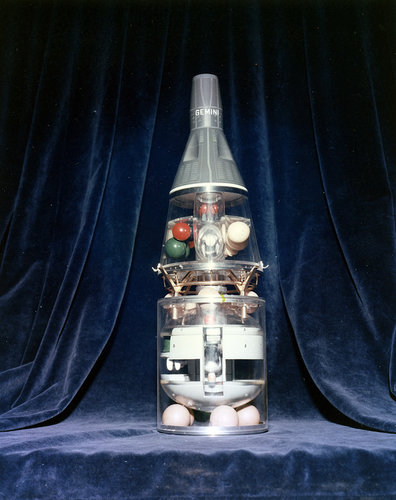
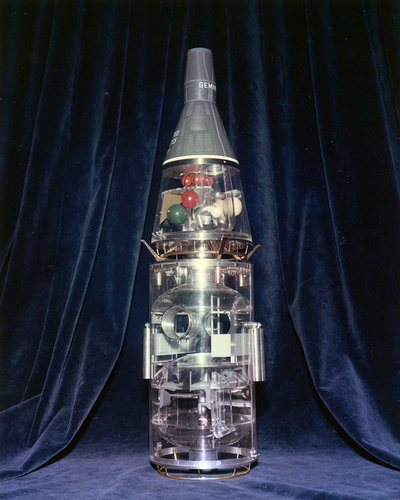
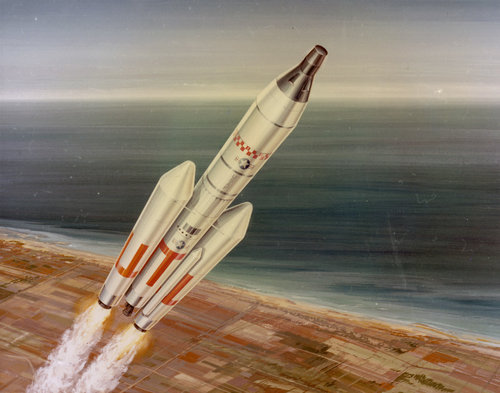
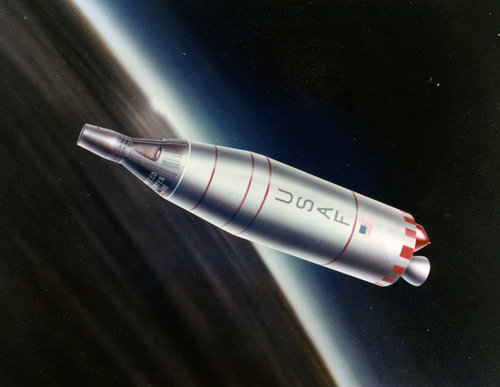
Last edited:
- Joined
- 13 August 2007
- Messages
- 8,412
- Reaction score
- 10,890
the two first are proposal for modular Space Station but not related to MOL
the tow last are proposal of Gemini with Transtage a orbital space craft like Space Rescue also not related to MOL.
the tow last are proposal of Gemini with Transtage a orbital space craft like Space Rescue also not related to MOL.
Possible upgrade of the Titan III with 156 inch SRMs was considered
in 1965 and 1967
(from astronautix)
1967 March 20
- MOL project delays, cost growth. -
Weight growth of the MOL station forced the Air Force to consider upgrading of the Titan booster. Stretching of the booster core or use of 156 inch solid rocket motors was considered. The Air Force also dithered as to whether to compete the Titan booster contract. Eight months were spent making the decision, and at the end of it all the first manned MOL flight was delayed to 1970 and the projected total cost increased from $ 1.5 billion to $ 2.2 billion.
1965
Would you happen to have the file linked above? I can't find it on DTIC.
- Joined
- 21 January 2015
- Messages
- 12,108
- Reaction score
- 16,251
Working in the shadow space program
A General Electric engineer’s work on MOL and other space programs
by Dwayne A. Day
Monday, May 4, 2020
Richard Passman, an engineer for General Electric, spent over a decade working on many missile and space programs, including as a senior manager of the Manned Orbiting Laboratory (MOL) program. Passman passed away April 1 at the age of 94 due to complications from the coronavirus. This article is based on an interview conducted with him by the author in January. We had planned to do a follow-up interview, but did not get the chance.
Possible upgrade of the Titan III with 156 inch SRMs was considered
in 1965 and 1967
(from astronautix)
1967 March 20
- MOL project delays, cost growth. -
Weight growth of the MOL station forced the Air Force to consider upgrading of the Titan booster. Stretching of the booster core or use of 156 inch solid rocket motors was considered. The Air Force also dithered as to whether to compete the Titan booster contract. Eight months were spent making the decision, and at the end of it all the first manned MOL flight was delayed to 1970 and the projected total cost increased from $ 1.5 billion to $ 2.2 billion.
1965
Would you happen to have the file linked above? I can't find it on DTIC.
Well I don't understand... If I downloaded that file with that number, it must have been available back then. I will try to check among my 6000 pdf to see if I can find it.
Shazaaaaam ! It is no longer on the DTIC but on the NRO declassified treasure trove (yaaaarn !)
Document 138 in the never-ending list below. Too big to attach here - can be dowloaded.
Cheers !
Document 138 in the never-ending list below. Too big to attach here - can be dowloaded.
Cheers !
Last edited:
- Joined
- 1 November 2009
- Messages
- 638
- Reaction score
- 428
- Joined
- 9 October 2009
- Messages
- 21,928
- Reaction score
- 13,554

MOL MH-5 Spacesuit: No Joy Today.
Two of the Space suits related to the USAF MOL space station program. Gemini’s pretty David Clark used by NASA in their missions and one of the stunning new designs created for the USAF progr…elpoderdelasgalaxias.wordpress.com
World B4
my bad y'all
- Joined
- 25 June 2017
- Messages
- 443
- Reaction score
- 360
I know that ther was talk of mounting space to space weapons on the MOL (Possibly after they realized that they needed it do do more than be an uber-expensive spy sat), but these plans weren't well developed beyond concepts. If anyone has any information in regards to this, or illustrations, I'd appreciate it.
- Joined
- 13 August 2007
- Messages
- 8,412
- Reaction score
- 10,890
I Check the NRO page for new MOL data
what i found was that the 825 documents from 2015 are gone
instead there now 42 PDF with new info on MOL
Allot study were made into reuse of MOL after mission with Gemini B with re supply Modul.
on long to be replaced reusable Spacecraft like Lifting Body or mini shuttle (NOT sts)
or use MOL complete Unmanned configuration
also installment of ELINT system on MOL and another system but all info about that is Black out
some of files show earlier concept of MOL with smaller optic launch on Titan IIIC with Tranststage in Back or the twin barrel concept
Or that USAF astronauts had 12.5 sec to make decision to take a photo, once they spot something interesting with the two periscopes installed in MOL
what i found was that the 825 documents from 2015 are gone
instead there now 42 PDF with new info on MOL
Allot study were made into reuse of MOL after mission with Gemini B with re supply Modul.
on long to be replaced reusable Spacecraft like Lifting Body or mini shuttle (NOT sts)
or use MOL complete Unmanned configuration
also installment of ELINT system on MOL and another system but all info about that is Black out
some of files show earlier concept of MOL with smaller optic launch on Titan IIIC with Tranststage in Back or the twin barrel concept
Or that USAF astronauts had 12.5 sec to make decision to take a photo, once they spot something interesting with the two periscopes installed in MOL
Seems they wanted in the long term to get ride of both Gemini B and Titan III, and have that thing boost itself into orbit, with drop tanks.
In the second half of the 60's Lockheed was working on FDL-5 shaped lifting bodies.
There was a small one, the L-301 with a Rocketdyne fluorine aerospike and drop tanks.
And a much larger one: the STAR-Clipper, with no fluorine, V-shaped drop tanks, and a bunch of RHEINBERRY XLR-129s in the back.
Later some of that research went into the ILRV program.
Now I'm wondering if they wre (even loosely) connected to the MOL. Or, alternatively, if some derivative of the MOL could get the fluorine aerospike and drop tanks to launch itself into orbit, without a Titan III and LC-6.
In the second half of the 60's Lockheed was working on FDL-5 shaped lifting bodies.
There was a small one, the L-301 with a Rocketdyne fluorine aerospike and drop tanks.
And a much larger one: the STAR-Clipper, with no fluorine, V-shaped drop tanks, and a bunch of RHEINBERRY XLR-129s in the back.
Later some of that research went into the ILRV program.
Now I'm wondering if they wre (even loosely) connected to the MOL. Or, alternatively, if some derivative of the MOL could get the fluorine aerospike and drop tanks to launch itself into orbit, without a Titan III and LC-6.
Last edited:
- Joined
- 13 August 2007
- Messages
- 8,412
- Reaction score
- 10,890
FighterJock
ACCESS: Above Top Secret
- Joined
- 29 October 2007
- Messages
- 5,580
- Reaction score
- 5,896
Next the FDL-5
They study also Martin X-24A type lifting body
some illustration show one of them docking with MOL
Nice find Michel Van, that is one part of the MOL that I have never heard about until now.
- Joined
- 13 August 2007
- Messages
- 8,412
- Reaction score
- 10,890
i not found that one, hidden at NRO
Found info about Atmosphere to be use in MOL
Source:(1) Chamber pressure: 27, 000 ft or 258 to 260 mm Hg
(2) Temperature range: 23° to 25° C
(3) Humidity range: 30 to 60 percent
(4) Partial pressure of the constituent atmospheric gases:
(a) Water vapor pressure: Approximately 10 mm ± 3
(b) Oxygen partial pressure: 182 mm or 70 percent
(c) Helium partial pressure 76 mm or 18 to 20 percent
(d) Carbon dioxide: < 1.6 percent or < 5 mm Hg
Vanderveen, J. E.; and Allen, T. H.: Evaluation of Feeding Systems for Manned Orbital Flight. Res. and Technol. Briefs AFSCRP 80-1, Mar. 1968.
260 mm Hg or 0.346 bar is same for Gemini capsule
Interesting is that instead of 30% nitrogen like AAP proposal and flow Skylab, USAF takes Helium !
- Joined
- 26 September 2008
- Messages
- 1,960
- Reaction score
- 744
Next the FDL-5
They study also Martin X-24A type lifting body
some illustration show one of them docking with MOL
That has been out for a long time. I saw it at the Martin archives over a decade ago, and I think it has been on the internet for quite a few years (soon after I visited they scanned that and some other MOL-related material that they then put on the internet).
But keep in mind that this was never taken very seriously. It was not the main part of MOL. Lots of things were considered for MOL and then discarded as MOL became focused entirely on its main mission and essentially split into manned and unmanned versions.
Similar threads
-
Convair Precursor Research and Application Module
- Started by Triton
- Replies: 2
-
-
Janus Manned Orbital Spacecraft with Stage Re-Entry
- Started by hesham
- Replies: 16
-
USAF interplanetary spacecraft concept using SPUR
- Started by Triton
- Replies: 15
-

